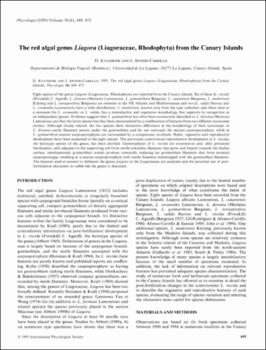The red algal genus Liagora (Liagoraceae, Rhodophyta) from the Canary Islands
Fecha
1995Resumen
Eight species of the genus Liagora (Liagoraceae, Rhodophyta) are reported from the Canary Islands. Six of these (L. viscida
(Forsskal) C. Agardh, L. distenta (Mertens) Lamouroux, L. gymnarthron Borgesen, L. canariensis Borgesen, L. maderensis
Kiitzing and L. tetrasporifera Borgesen) are endemic to the NE Atlantic and Mediterranean and two (L. valida Harvey and
L. ceranoides Lamouroux) have a wide distribution. L. maderensis, known only from the type collection and often cited as
a synonym for L. ceranoides or L. valida, has a reproductive and vegetative morphology that supports its recognition as
an independent species. Evidence suggests that L. gymnarthron has often been erroneously identified as L. distenta (Mertens)
Lamouroux and that the latter species has thus been characterized by a combination of features from two different taxonomic
entities. Although closely related, the two species show distinctive differences in the morphology of their cystocarps: in
L. distenta sterile filaments persist under the gonimoblast and do not surround the mature carposporophyte, while in
L. gymnarthron mature carposporophytes are surrounded by a conspicuous involuc�e. Habit, vegetative and reproductive
development have been examined in the eight species. The previously controversial reproductive development in L. viscida,
the lectotype species of the genus, has been clarified. Gametophytes of L. viscida are monoecious and, after presumed
fertilization, cells adjacent to the supporting cell form sterile colourless filaments that grow and branch towards the thallus
surface; simultaneously gonimoblast initials produce outwardly radiating lax gonimoblast filaments that form terminal
carposporangia, resulting in a mature carposporophyte with sterile filaments intermingled with the gonimoblast filaments.
The features used at present to delineate the genus Liagora in the Liagoraceae are analysed and the potential use of postfertilization characters to subdivide the genus is discussed.






